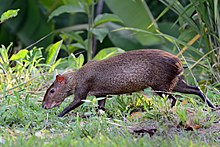Dasyproctidae
| Dasyproctidae | |
|---|---|

| |
| Central American agouti, D. punctata | |
| Scientific classification | |
| Domain: | Eukaryota |
| Kingdom: | Animalia |
| Phylum: | Chordata |
| Class: | Mammalia |
| Order: | Rodentia |
| Superfamily: | Cavioidea
|
| Family: | Dasyproctidae Gray 1825 |
| Type genus | |
Dasyprocta
, 1811 | |
| Genera | |
Dasyproctidae is a family of large South American rodents, comprising the agoutis and acouchis.[1] Their fur is a reddish or dark colour above, with a paler underside. They are herbivorous, often feeding on ripe fruit that falls from trees. They live in burrows, and, like squirrels, will bury some of their food for later use.[2]
Dasyproctids exist in Central and South America, which are the tropical parts of the New World. The fossil record of this family can be traced back to the Late Oligocene (Deseadan in the SALMA classification).
As with all rodents, members of this family have incisors, pre-molars, and molars, but no canines. The cheek teeth are
Classification
Fossil taxa follow McKenna and Bell,[3] with modifications following Kramarz.[4]
- Family Dasyproctidae
- Genus †Alloiomys
- Genus †Australoprocta
- Genus †Branisamys
- Genus †Incamys
- Genus †Neoreomys
- Genus †Megastus
- Genus †Palmiramys
- Genus Dasyprocta
- Azara's agouti, D. azarae
- Coiban agouti, D. coibae
- Crested agouti, D. cristata
- Black agouti, D. fuliginosa
- Orinoco agouti, D. guamara
- Kalinowski's agouti, D. kalinowskii
- Red-rumped agouti, D. leporina
- Mexican agouti, D. mexicana
- Black-rumped agouti, D. prymnolopha
- Central American agouti, D. punctata
- Ruatan Island agouti, D. ruatanica
- Genus Myoprocta
- Green acouchi, M. pratti
- Red acouchi, M. acouchy
The pacas (genus Cuniculus) are placed by some authorities[3][5] in Dasyproctidae, but molecular studies have demonstrated they do not form a monophyletic group.[6]
References
- OCLC 62265494.
- ISBN 0-87196-871-1.
- ^ ISBN 0-231-11013-8.
- ^ Kramarz, A. G. (2005). "A primitive cephalomyid hystricognath rodent from the early Miocene of northern Patagonia, Argentina". Acta Palaeontologica Polonica. 50 (2): 249–258.
- ^ Woods, C. A. (1993). "Hystricognathi". In Wilson, D. E.; Reeder, D. M. (eds.). Mammal Species of the World: A Taxonomic and Geographic Reference. Washington D.C.: Smithsonian Institution Press.
- PMID 11861886.
